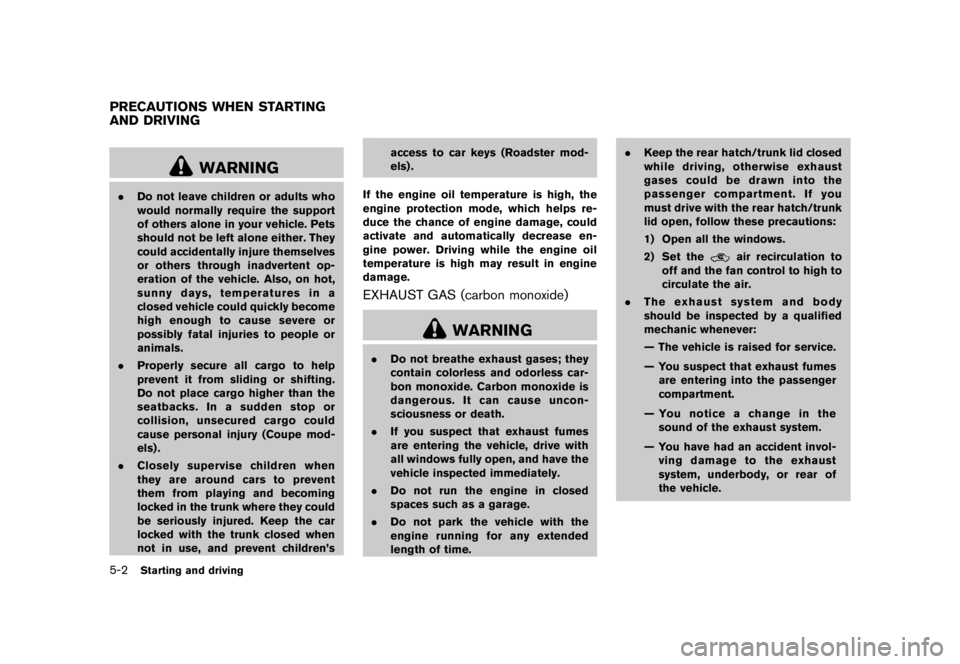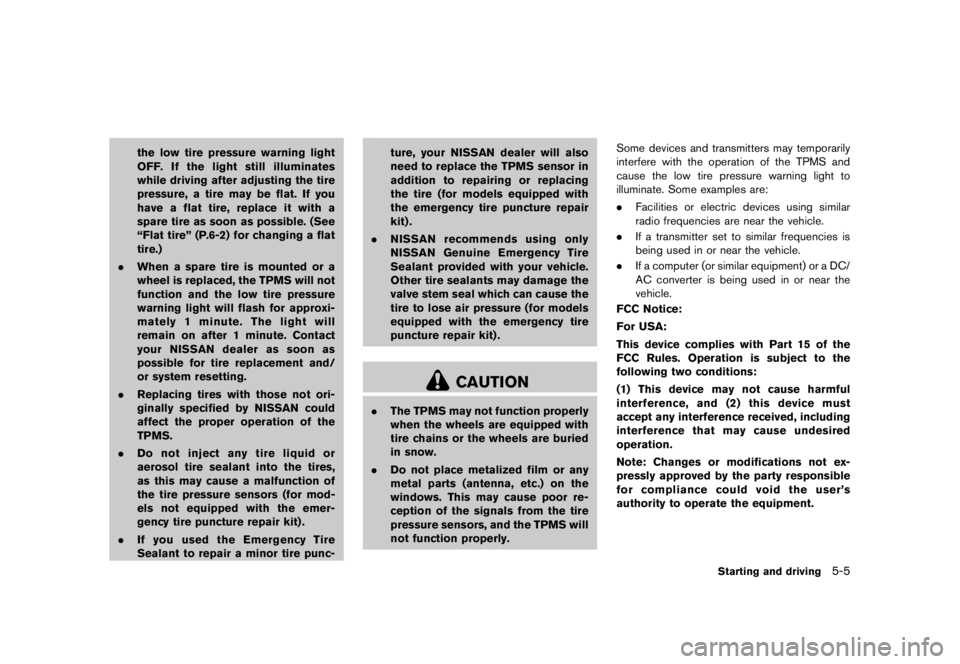2011 NISSAN 370Z warning light
[x] Cancel search: warning lightPage 227 of 1281

TirePressure, Low tire pressure warning light ...
..... 2-12
Sealant ...
....................................................................... 6-8
Tire replacement indicator ...
................................. 2-21
Tires Emergency tire puncture repair kit ...
..................... 6-8
Flat tire ...
....................................................................... 6-2
Low tire pressure warning system ...
...................... 5-3
Spare tire ...
................................................................ 8-40
Tire and Loading information label ...
....... 8-32, 9-13
Tire chains ...
.............................................................. 8-37
Tire dressing ...
............................................................. 7-5
Tire pressure ...
......................................................... 8-31
Tire pressure monitoring
system (TPMS) ...
............................................... 5-3, 6-2
Tire rotation ...
............................................................ 8-38
Types of tires ...
......................................................... 8-36
Uniform tire quality grading ...
............................... 9-21
Wheel/tire size ...
......................................................... 9-9
Wheels and tires ...
.................................................. 8-31
Tonneau cover (see cargo cover) ...
........................... 2-43
Top, Soft top ...
................................................................ 3-21
Touch screen ...
.................................................................. 4-4
Towing Flat towing ...
............................................................. 9-21
Tow truck towing ...
.................................................. 6-18
Towing a trailer ...
..................................................... 9-20
TPMS, Tire pressure monitoring system ...
................. 5-3
TPMS, Tire pressure warning system ...
...................... 6-2
Trailer towing ...
................................................................ 9-20
Transceiver, HomeLink
®
Universal Transceiver ...
...................................... 2-50, 2-54
Transmission Automatic transmission fluid (ATF) ...
.................. 8-13
Driving with automatic transmission ...
................ 5-12
Driving with manual transmission ...
..................... 5-16
Transmission selector lever lock release ...
........ 5-16 Transmitter (See remote keyless entry system)
...
.... 3-13
Traveling or registering your vehicle in
another country ...
............................................................ 9-11
Trip computer ...
............................................................... 2-22
Trip odometer ...
............................................................... 2-24
Triple meter ...
..................................................................... 2-8
Trunk Interior trunk lid release ...
...................................... 3-19
Light ...
......................................................................... 2-49
Secondary trunk lid release ...
............................... 3-20
Trunk lid ...
.................................................................. 3-18
Trunk release power cancel switch ...
................. 3-19
Turn signal switch ...
....................................................... 2-35
U
Underbody cleaning ...
..................................................... 7-4
Uniform tire quality grading ...
...................................... 9-21
USB memory operation ...
............................................. 4-61
V
Vanity mirror ...
.................................................................. 3-39
Vanity mirror lights ...
...................................................... 2-48
Variable voltage control system ...
............................... 8-18
Vehicle Dimensions ...
............................................................ 9-10
Identification number (VIN) ...
................................ 9-11
Information and settings (models with
navigation system) ...
.................................................. 4-7
Information display ...
............................................... 2-17
Loading information ...
............................................. 9-18
Recovery (freeing a stuck vehicle) ...
.................. 6-21
Security system ...
.................................................... 2-27
Vehicle dynamic control (VDC) off switch ...
..... 2-39
Vehicle dynamic control (VDC) system ...
.......... 5-28
Ventilators ...
...................................................................... 4-24 Voice command (Bluetooth
®Hands-Free
Phone System) ...
............................................................ 4-94
Voice command (NISSAN voice
recognition system) ...
................................................. 4-106
Voltmeter ...
......................................................................... 2-8
W
Warning
Hazard warning flasher switch ...
.......................... 2-36
Lights ...
....................................................................... 2-10
Tire pressure monitoring
system (TPMS) ...
............................................... 5-3, 6-2
Warning/indicator lights and
audible reminders ...
.................................................... 2-9
Warning labels, Air bag warning labels ...
................. 1-40
Warning light Air bag warning light ...
................................ 1-40, 2-13
Anti-lock braking system (ABS)
warning light ...
.......................................................... 2-10
Brake warning light ...
.............................................. 2-10
Intelligent Key system warning light ...
................ 2-11
Low tire pressure warning light ...
........................ 2-12
Seat belt warning light and chime ...
................... 2-13
Warnings and alerts (vehicle
information display) ...
..................................................... 2-20
Warranty, Emission control system warranty ...
....... 9-22
Washer switch, Windshield wiper and
washer switch ...
.............................................................. 2-30
Washing ...
........................................................................... 7-2
Waxing ...
............................................................................. 7-4
Wheel/tire size ...
............................................................... 9-9
Wheels and tires ...
......................................................... 8-31
Care of wheels ...
........................................................ 7-4
Cleaning aluminum alloy wheels ...
......................... 7-5
Window washer fluid ...
................................................. 8-15
Page 290 of 1281

pressure telltale.
Your vehicle has also been equipped with a
TPMS malfunction indicator to indicate when the
system is not operating properly. The TPMS
malfunction indicator is combined with the low
tire pressure telltale. When the system detects a
malfunction, the telltale will flash for approxi-
mately one minute and then remain continuously
illuminated. This sequence will continue upon
subsequent vehicle start-ups as long as the
malfunction exists. When the malfunction indi-
cator is illuminated, the system may not be able
to detect or signal low tire pressure as intended.
TPMS malfunctions may occur for a variety of
reasons, including the installation of replace-
ment or alternate tires or wheels on the vehicle
that prevent the TPMS from functioning properly.
Always check the TPMS malfunction telltale
after replacing one or more tires or wheels on
your vehicle to ensure that the replacement or
alternate tires and wheels allow the TPMS to
continue to function properly.
Additional informationGUID-F08D0811-1070-4649-89CE-0F3AF1BDE3F8.The TPMS does not monitor the tire
pressure of the spare tire.
. The TPMS will activate only when the
vehicle is driven at speeds above 16 MPH
(25 km/h) . Also, this system may not detect
a sudden drop in tire pressure (for example a flat tire while driving) .
. The low tire pressure warning light does not
automatically turn off when the tire pressure
is adjusted. After the tire is inflated to the
recommended pressure, the vehicle must be
driven at speeds above 16 MPH (25 km/h)
to activate the TPMS and turn off the low tire
pressure warning light. Use a tire pressure
gauge to check the tire pressure.
. The CHECK TIRE PRESSURE warning also
appears on the vehicle information display
when the low tire pressure warning light is
illuminated and low tire pressure is detected.
The CHECK TIRE PRESSURE warning
turns off when the low tire pressure warning
light turns off.
The CHECK TIRE PRESSURE warning
appears each time the ignition switch is
placed in the ON position as long as the low
tire pressure warning light remains illumi-
nated.
The CHECK TIRE PRESSURE warning
does not appear if the low tire pressure
warning light illuminates to indicate a TPMS
malfunction.
. Tire pressure rises and falls depending on
the heat caused by the vehicle’s operation
and the outside temperature. Low outside
temperature can lower the temperature of the air inside the tire which can cause a
lower tire inflation pressure. This may cause
the low tire pressure warning light to
illuminate. If the warning light illuminates in
low ambient temperature, check the tire
pressure for all four tires.
For additional information, see “Low tire pres-
sure warning light” (P.2-12) and “Tire Pressure
Monitoring System (TPMS)” (P.6-2) .
Page 293 of 1281

paired, by a NISSAN dealer promptly. (See
“Anti-lock Braking System (ABS) warning light”
(P.2-10) .)
Page 297 of 1281

If this indicator light remains on for 20 seconds
and then blinks for 10 seconds when the engine
is not running, it indicates that the vehicle is not
ready for an emission control system inspection/
maintenance test. (See “Readiness for Inspec-
tion/Maintenance (I/M) test” (P.9-24) .)
Operation:
GUID-D73A39BF-43C8-459F-9C24-47B7F579C407The malfunction indicator light will come on in
one of two ways:
.Malfunction indicator light on steady — An
emission control system malfunction has
been detected. Check the fuel-filler cap if
the LOOSE FUEL CAP warning appears in
the vehicle information display. If the fuel-
filler cap is loose or missing, tighten or install
the cap and continue to drive the vehicle.
The
Page 358 of 1281

This means the system is operational.
If any of the following conditions occur, the front
air bag, side air bag, curtain air bag and
pretensioner systems need servicing:
.The supplemental air bag warning light
remains on approximately 7 seconds after
the ignition switch is pushed to the ON
position.
. The supplemental air bag warning light
flashes intermittently.
. The supplemental air bag warning light does
not come on at all.
Under these conditions, the front air bag, side air
bag, curtain air bag or pretensioner systems may
not operate properly. They must be checked and
repaired. Take your vehicle to the nearest
NISSAN dealer.
Page 403 of 1281

sensor to turn the air bag OFF. Always be sure
to be seated and wearing the seat belt properly
for the most effective protection by the seat belt
and supplemental air bag.
The occupant classification sensor is designed
to operate as described above to turn the front
passenger air bag OFF for specified child
restraints. Failing to properly secure child
restrains and to use the ALR mode (child
restraint mode) may allow the restraint to tip or
move in an accident or sudden stop. This can
also result in the passenger air bag inflating in a
crash instead of being OFF. (See “Child
restraints” (P.1-18) for proper use and installa-
tion.)
If the front passenger seat is not occupied, the
passenger air bag is designed not to inflate in a
crash. However, heavy objects placed on the
seat could result in air bag inflation, because of
the object being detected by the occupant
classification sensor. Other conditions could
also result in air bag inflation, such as if a child is
standing on the seat, or if two children are on the
seat, contrary to the instructions in this manual.
Always be sure that you and all vehicle
occupants are seated and restrained properly.
Using the passenger air bag status light, you can
monitor when the front passenger air bag is
automatically turned OFF with the seat occu-pied. The light will not illuminate when the front
passenger seat is unoccupied.
If an adult occupant is in the seat but the
passenger air bag status light is illuminated
(indicating that the air bag is OFF) , it could be
that the person is a small adult, or is not sitting
on the seat properly.
If a child restraint must be used in the front seat,
the passenger air bag status light may or may
not be illuminated, depending on the size of the
child and the type of child restraint being used. If
the passenger air bag status light is not
illuminated (indicating that the air bag might
inflate in a crash), it could be that the child
restraint or seat belt is not being used properly.
Make sure that the child restraint is installed
properly, the seat belt is used properly and the
occupant is positioned properly. If the passen-
ger air bag status light is still not illuminated, try
a different child restraint.
If the passenger air bag status light will not
illuminate even though you believe that the child
restraint, the seat belts and the occupant are
properly positioned, the system may be sensing
an unoccupied seat (in which case the air bag is
OFF). Your NISSAN dealer can check that the
system is OFF by using a special tool. However,
until you have confirmed with your dealer that
your air bag is working properly, do not transporta child in this vehicle.
The NISSAN Advanced Air Bag System and
passenger air bag status light will take a few
seconds to register a change in the passenger
seat status. However, if the seat becomes
unoccupied, the air bag status light will remain
off.
If a malfunction occurs in the front passenger air
bag system, the supplemental air bag warning
light
Page 480 of 1281

sensor to turn the air bag OFF. Always be sure
to be seated and wearing the seat belt properly
for the most effective protection by the seat belt
and supplemental air bag.
The occupant classification sensor is designed
to operate as described above to turn the front
passenger air bag OFF for specified child
restraints. Failing to properly secure child
restrains and to use the ALR mode (child
restraint mode) may allow the restraint to tip or
move in an accident or sudden stop. This can
also result in the passenger air bag inflating in a
crash instead of being OFF. (See “Child
restraints” (P.1-18) for proper use and installa-
tion.)
If the front passenger seat is not occupied, the
passenger air bag is designed not to inflate in a
crash. However, heavy objects placed on the
seat could result in air bag inflation, because of
the object being detected by the occupant
classification sensor. Other conditions could
also result in air bag inflation, such as if a child is
standing on the seat, or if two children are on the
seat, contrary to the instructions in this manual.
Always be sure that you and all vehicle
occupants are seated and restrained properly.
Using the passenger air bag status light, you can
monitor when the front passenger air bag is
automatically turned OFF with the seat occu-pied. The light will not illuminate when the front
passenger seat is unoccupied.
If an adult occupant is in the seat but the
passenger air bag status light is illuminated
(indicating that the air bag is OFF) , it could be
that the person is a small adult, or is not sitting
on the seat properly.
If a child restraint must be used in the front seat,
the passenger air bag status light may or may
not be illuminated, depending on the size of the
child and the type of child restraint being used. If
the passenger air bag status light is not
illuminated (indicating that the air bag might
inflate in a crash), it could be that the child
restraint or seat belt is not being used properly.
Make sure that the child restraint is installed
properly, the seat belt is used properly and the
occupant is positioned properly. If the passen-
ger air bag status light is still not illuminated, try
a different child restraint.
If the passenger air bag status light will not
illuminate even though you believe that the child
restraint, the seat belts and the occupant are
properly positioned, the system may be sensing
an unoccupied seat (in which case the air bag is
OFF). Your NISSAN dealer can check that the
system is OFF by using a special tool. However,
until you have confirmed with your dealer that
your air bag is working properly, do not transporta child in this vehicle.
The NISSAN Advanced Air Bag System and
passenger air bag status light will take a few
seconds to register a change in the passenger
seat status. However, if the seat becomes
unoccupied, the air bag status light will remain
off.
If a malfunction occurs in the front passenger air
bag system, the supplemental air bag warning
light
Page 485 of 1281

This means the system is operational.
If any of the following conditions occur, the front
air bag, side air bag, curtain air bag and
pretensioner systems need servicing:
.The supplemental air bag warning light
remains on approximately 7 seconds after
the ignition switch is pushed to the ON
position.
. The supplemental air bag warning light
flashes intermittently.
. The supplemental air bag warning light does
not come on at all.
Under these conditions, the front air bag, side air
bag, curtain air bag or pretensioner systems may
not operate properly. They must be checked and
repaired. Take your vehicle to the nearest
NISSAN dealer.